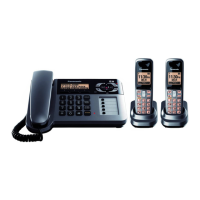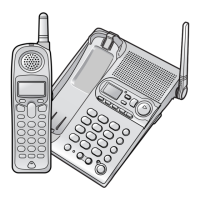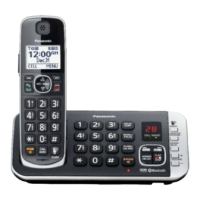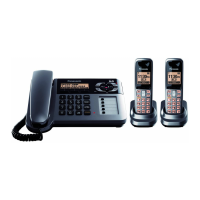Why can't I activate eco mode on my Panasonic KX-TGD320AL?
- DDeanna BrownSep 13, 2025
If you cannot activate the eco mode on your Panasonic Answering Machine, it is because you have set the repeater mode to 'On'. Set the repeater mode to 'Off'.
Why can't I activate eco mode on my Panasonic KX-TGD320AL?
If you cannot activate the eco mode on your Panasonic Answering Machine, it is because you have set the repeater mode to 'On'. Set the repeater mode to 'Off'.
How to turn on Panasonic KX-TGD320AL handset?
If the Panasonic Answering Machine handset does not turn on even after installing charged batteries, place the handset on the base unit or charger to turn on the handset.
How to fix Panasonic KX-TGD320AL not recording messages?
If your Panasonic Answering Machine is not recording new messages, ensure the answering system is turned on. Also, check if the message memory is full and erase any unwanted messages. Verify that the recording time is not set to “Greeting Only”, and adjust the setting if needed. Ensure that other devices, such as handsets, are not engaged in a call, as the answering system will not answer incoming calls during that time. Finally, your phone service provider’s voicemail service may be answering calls before the unit; in this case, change the unit’s number of rings setting to a lower value.
What to do if my Panasonic KX-TGD320AL got wet?
If liquid or other form of moisture has entered the handset/base unit of your Panasonic Answering Machine, disconnect the AC adaptor and telephone line cord from the base unit. Remove the batteries from the handset and leave to dry for at least 3 days. After the handset/base unit are completely dry, reconnect the AC adaptor and telephone line cord. Insert the batteries and charge fully before use. If the unit does not work properly, contact an authorised service centre.
Why can't I register a handset to the base unit on my Panasonic KX-TGD320AL?
Here are possible solutions if you cannot register a handset to a base unit of your Panasonic Answering Machine: 1. The maximum number of base units (4) is already registered to the handset, so cancel unused base unit registrations from the handset. 2. The maximum number of handsets (6) is already registered to the base unit, so cancel unused handset registrations from the base unit. 3. If you entered the wrong PIN, contact an authorised service centre if you forget your PIN.
Why can't I register my Panasonic Answering Machine handset?
If you cannot register a handset to a base unit on your Panasonic Answering Machine, it may be because the maximum number of base units (4) is already registered to the handset; cancel unused base unit registrations from the handset. The maximum number of handsets (6) may already be registered to the base unit; cancel unused handset registrations from the base unit. Alternatively, you may have entered the wrong PIN.
Why are the batteries on my Panasonic KX-TGD320AL still flashing after charging?
If you fully charged the batteries of your Panasonic Answering Machine, but it still flashes or the operating time seems to be shorter, clean the battery ends and the charge contacts with a dry cloth and charge again. It may also be time to replace the batteries.
What does it mean when my Panasonic KX-TGD320AL displays the symbol?
If your Panasonic Answering Machine is displaying , the handset is too far from the base unit, so move closer. Ensure the base unit’s AC adaptor is properly connected by reconnecting it to the base unit. The handset may not be registered to the base unit, so register it. Activating eco mode reduces the range of the base unit in standby mode, so turn eco mode off if required.
Why is my Panasonic KX-TGD320AL not ringing enough times?
If the unit does not emit the specified number of rings on your Panasonic Answering Machine, it is because if the first ring is turned off, the number of rings decreases by 1 from the specified number of rings.
Why is my Panasonic KX-TGD320AL Answering Machine base unit not ringing?
If the base unit of your Panasonic Answering Machine does not ring, the ringer volume may be turned off. Adjust the ringer volume.
Details the product models and their components.
Lists supplied accessories with part numbers and quantities.
Information on adding optional handsets to extend system range.
Safety precautions for preventing injury and property loss.
Precautions for safe operation and maintenance of the product.
Information on battery types, handling, and charging.
Essential safety precautions to reduce risks during use.
Technical specifications of the digital cordless answering system.
Step-by-step guide for connecting the base unit and charger.
Instructions for charging the handset batteries.
Identifies controls on the handset and base unit.
Explains the meaning of various icons shown on the handset display.
Instructions on how to switch the unit on and off.
Steps to set the unit's date and time.
How to change the display language of the unit.
Information and settings for the power-saving Eco Mode.
Procedures for placing, receiving, and ending calls.
Details on Hold, Mute, Recall/Flash, and Equalizer.
How to use intercom and transfer/conference calls.
How the unit functions during a power failure.
Adding, storing, editing, and deleting phonebook contacts.
Assigning phone numbers to speed dial keys for quick access.
Accessing features via menus or direct command codes.
Configuring ringers, DND, alarms, call blocking, and display.
Setting up Key Finder, Eco Mode, Security, and Repeater.
Adding and managing handsets and base units.
How caller information is displayed and logged.
Important notes and viewing the caller list.
Setting up greetings, recording, and turning system on/off.
Playing, erasing, and navigating through recorded messages.
Alerting, remote access, and call back features.
Configuring call screening, recording time, and greeting options.
Information on phone service provider voicemail features.
Using dial keys to enter text and numbers.
Lists common display messages and their causes/solutions.
Solutions for common problems with the unit.
Details the product models and their components.
Lists supplied accessories with part numbers and quantities.
Information on adding optional handsets to extend system range.
Safety precautions for preventing injury and property loss.
Precautions for safe operation and maintenance of the product.
Information on battery types, handling, and charging.
Essential safety precautions to reduce risks during use.
Technical specifications of the digital cordless answering system.
Step-by-step guide for connecting the base unit and charger.
Instructions for charging the handset batteries.
Identifies controls on the handset and base unit.
Explains the meaning of various icons shown on the handset display.
Instructions on how to switch the unit on and off.
Steps to set the unit's date and time.
How to change the display language of the unit.
Information and settings for the power-saving Eco Mode.
Procedures for placing, receiving, and ending calls.
Details on Hold, Mute, Recall/Flash, and Equalizer.
How to use intercom and transfer/conference calls.
How the unit functions during a power failure.
Adding, storing, editing, and deleting phonebook contacts.
Assigning phone numbers to speed dial keys for quick access.
Accessing features via menus or direct command codes.
Configuring ringers, DND, alarms, call blocking, and display.
Setting up Key Finder, Eco Mode, Security, and Repeater.
Adding and managing handsets and base units.
How caller information is displayed and logged.
Important notes and viewing the caller list.
Setting up greetings, recording, and turning system on/off.
Playing, erasing, and navigating through recorded messages.
Alerting, remote access, and call back features.
Configuring call screening, recording time, and greeting options.
Information on phone service provider voicemail features.
Using dial keys to enter text and numbers.
Lists common display messages and their causes/solutions.
Solutions for common problems with the unit.
| Type | Cordless Phone |
|---|---|
| Number of Handsets | 1 |
| Expandable up to | 6 Handsets |
| Caller ID | Yes |
| Call Waiting Caller ID | Yes |
| Call Block | Yes |
| Speakerphone | Yes |
| Intercom | Yes |
| DECT Technology | Yes |
| Frequency | 1.9 GHz |
| Battery Type | Ni-MH |
| Display | LCD |
| Keypad on Base | Yes |
| Answering System | Digital |
| Phonebook Capacity | 100 |
| Range | 50 m (Indoor) / 300 m (Outdoor) |












